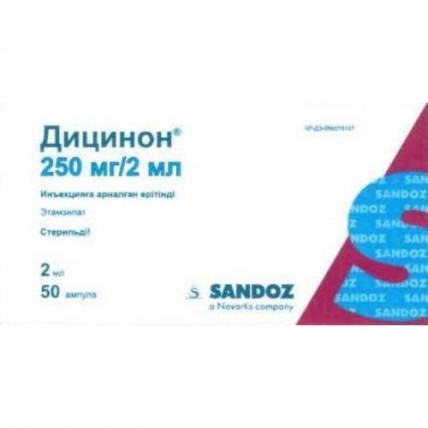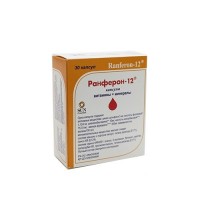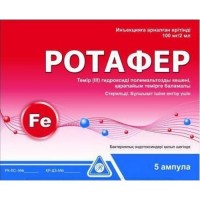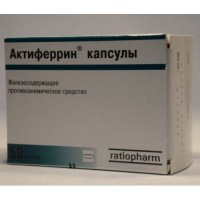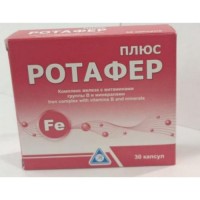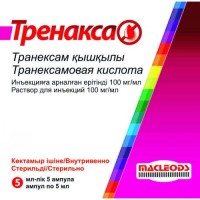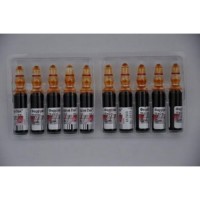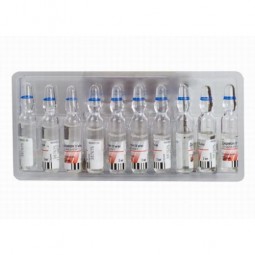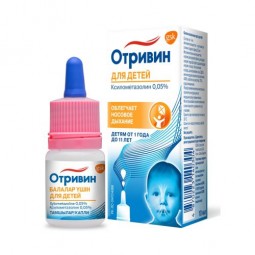Dicynonum 250 mg / 2 ml 50s solution for injection in ampoules
- $66.00
The instruction for medical use
of Ditsinon® medicine
the Trade name
of Ditsinon®
the International unlicensed
name Etamsylate Dosage Form Solution for injections of 250 mg / 2 ml
One ampoule contain Structure:
active agent - etamsylate of 250 mg,
excipients: sodium metabisulphite, Natrii hydrocarbonas, water for injections.
The description
Transparent colourless solution, practically without visible particles.
Pharmacotherapeutic group
of Gemostatiki. Vitamin K and other haemo statics. Other system haemo statics. Etamsylate.
The ATX B02BX01 code
the Pharmacological
Pharmacokinetics Distribution Later properties of intramuscular administration of drug in a dose of 500 mg the maximum kocentration in blood plasma makes 30-50 mkg/ml and is reached within an hour. After intravenous administration of drug the maximum kocentration in blood plasma is reached within 10 minutes and makes 50 mkg/ml.
Extent of linking with proteins of blood plasma makes about 95%. Etamsylate gets through a placental barrier. Maternal and umbilical blood contain similar concentration of etamsylate. It is unknown whether etamsylate gets into breast milk.
Metabolism
Etamsylate is not metabolized.
Removal Etamsylate is removed by kidneys. About 85% of the entered dose are removed with urine in not changed look within the first day.
The semi-elimination period is about 2 hours of plasma of intravenously entered etamsylate.
Pharmacokinetics at patients with abnormal liver functions and kidneys
Pharmacokinetic properties of etamsylate at patients with abnormal liver functions and kidneys were not studied.
The pharmacodynamics Etamsylate is the synthetic styptic and angioprotektorny drug used as primary styptic means (interaction of an endothelium thrombocytes). Дицинон® increases platelet stickness, normalizes stability of walls of capillaries, reducing thus their permeability, inhibits biosynthesis of prostaglandins which cause disaggregation of thrombocytes, a vazodilatation and hyperpermeability of capillaries. As a result of it the bleeding time considerably decreases, blood loss decreases.
Etamsylate does not possess vasoconstrictive action, does not affect a fibrinolysis and does not change plasma coagulation factors.
Indications
- prevention and treatment of capillary bleedings of various etiology and localization: to, in time and after surgeries and also on all well vaskulyarizovanny fabrics in otolaryngology, gynecology, obstetrics, urology, stomatology, ophthalmology, plastic and reconstructive surgery
In a neonatology
- prevention of periventrikulyarny bleeding at premature children
the Route of administration and doses
Use for adults and children is more senior than 14 years
During the preoperative period: 2 - 4 ml (250 - 500 mg) intravenously or intramusculary in 1 hour prior to operation.
During operation: on 2 - 4 ml (250 - 500 mg) intravenously, if necessary the dose can be repeated.
During the postoperative period of 2 - 4 ml (250 - 500 mg) each 4-6 hours before disappearance of risk of developing bleeding.
In case of emergency, according to weight of a case: 2 - 4 ml intravenously or intramusculary each 4-6 hours before disappearance of risk of developing bleeding.
It is possible to perform topical treatment of Ditsinon® locally (a skin transplant, odontectomy) by means of the sterile gauze napkin moistened with drug. Perhaps combined use of an oral form of drug with parenteral administration.
Use for children
the Daily dose for children makes a half of a dose for adults. In a neonatology: the drug has to be administered intramusculary 10 mg/kg of body weight (0.1 ml = 12.5 mg), within 2 hours after the birth, and then each 6 hours within 4 days.
Patients with abnormal liver functions and kidneys.
The clinical recommendations about dosing made relatively are not enough therefore at such patients drug should be used with care.
Side effects
By-effects are classified by frequency: very often (≥1/10), it is frequent (≥1/100, & lt, 1/10), infrequently (& gt, 1/1000 and & lt, 1/100), is rare (≥1/10000, & lt, 1/1000), is very rare (& lt, 1/10000) and unknown frequency (which frequency cannot be determined on the basis of the available data).
Infrequently
- a lowering of arterial pressure
- the heavy feeling in heart
- hyperaemia of the person, paresthesia of the lower extremities
Seldom
- a headache
- bitterness in a mouth, nausea, vomiting, heartburn
- skin rash
- spin / lower back pain
Is very rare
- allergic reactions (skin rashes, an acute anaphylaxis, life-threatening attacks of asthma)
- a sharp porphyria
-
the Contraindication tromboemoliya
- hypersensitivity to active ingredient of drug – to etamsylate or to any of excipients
- a sharp porphyria
- bronchial asthma
- thrombosis, a thrombembolia in the anamnesis
- bleedings against the background of overdose of anticoagulants
- an abnormal liver function and kidneys (there is no clinical experience of use)
- the lactation period
Medicinal interactions
Solution is not applied to injections along with the solutions containing sodium bicarbonate or sodium lactate.
If to mix Ditsinon® with normal saline solution, then it should be entered immediately at intravenous drop administration. Дицинон® it is impossible to mix in one syringe with other drugs. Thiamine (B1 vitamin) is inactivated by the sulfite which is contained in solution for drug Ditsinon® injections.
Use of etamsylate for 1 h before introduction of dextrans (for example a reopoliglyukina) prevents their antiagregantny action, after introduction of the last — has no haemo static effect.
The special
instructions Drug it is not effective at patients with thrombocytopenia. At the hemorrhagic complications connected with overdose of anticoagulants it is recommended to use specific antidotes. Use of the drug Ditsinon® for patients with the broken indicators of a coagulant system of blood is possible, but it has to be complemented with administration of the drugs eliminating the revealed deficiency or defect of factors of a coagulant system of blood.
As parenteral administration of the drug Ditsinon® can cause lowering of blood pressure, it is necessary to exercise careful control of the patients suffering from differences of arterial blood pressure or hypotonia
of Ditsinon® solution for injections metabisulphite (E223) contains in quality of antioxidant sodium excipient. Sulfites can cause allergic reactions, nausea, diarrhea in sensitive patients. It was reported about separate cases of emergence of an acute anaphylaxis and life-threatening attacks of bronchial asthma. The hypersensitivity to sulfites is more often noted at patients with bronchial asthma.
In case of emergence allergic reactions drug treatment should be stopped immediately.
Pregnancy and a lactation
Safety of use of drug at pregnancy is not established. Дицинон® it is necessary to apply at pregnancy only in individual cases if it is considered necessary when the potential advantage for mother exceeds potential risk for the child.
In need of prescribing of drug in the period of a lactation it is necessary to resolve an issue of the breastfeeding termination.
There Is no feature of influence of medicine on ability to run the vehicle or potentially dangerous mechanisms data on influence of drug on ability to run the vehicle or potentially dangerous mechanisms demanding concentration of attention.
Overdose
Cases of overdose are not revealed. In case of overdose symptomatic treatment.
The form of release and packing
On 2 ml in ampoules of colourless glass (class I EF) with a red dot for a break is higher than a neck.
On 10 ampoules place in blister strip packaging from a film polyvinylchloride. On 5 planimetric packs together with the instruction for medical use in the state and Russian languages put in a box of cardboard.
To Store storage conditions at a temperature not above 25 °C, in the place protected from light.
To store out of children's reach!
Not to use a period of storage of 5 years after the expiry date specified on packing.
Prescription status
According to the prescription
the Producer/packer/owner of the registration certificate
Lek Pharmasyyutikals of d, Slovenia
Verovskova 57, Ljubljana, Slovenia
the Address of the organization accepting in the territory of the Republic of Kazakhstan claims from consumers on quality of products (goods) Representative office of JSC Sandoz Pharmasyyutikals d. d. in Republic of Kazakhstan Almaty, Luganskogo St. 96, the Phone number - 258 10 48, fax: +7 727 258 10 47 e-mail-mail
to Develop
of Ditsinon® medicine
the Trade name
of Ditsinon®
the International unlicensed
name Etamsylate Dosage Form Solution for injections of 250 mg / 2 ml
One ampoule contain Structure:
active agent - etamsylate of 250 mg,
excipients: sodium metabisulphite, Natrii hydrocarbonas, water for injections.
The description
Transparent colourless solution, practically without visible particles.
Pharmacotherapeutic group
of Gemostatiki. Vitamin K and other haemo statics. Other system haemo statics. Etamsylate.
The ATX B02BX01 code
the Pharmacological
Pharmacokinetics Distribution Later properties of intramuscular administration of drug in a dose of 500 mg the maximum kocentration in blood plasma makes 30-50 mkg/ml and is reached within an hour. After intravenous administration of drug the maximum kocentration in blood plasma is reached within 10 minutes and makes 50 mkg/ml.
Extent of linking with proteins of blood plasma makes about 95%. Etamsylate gets through a placental barrier. Maternal and umbilical blood contain similar concentration of etamsylate. It is unknown whether etamsylate gets into breast milk.
Metabolism
Etamsylate is not metabolized.
Removal Etamsylate is removed by kidneys. About 85% of the entered dose are removed with urine in not changed look within the first day.
The semi-elimination period is about 2 hours of plasma of intravenously entered etamsylate.
Pharmacokinetics at patients with abnormal liver functions and kidneys
Pharmacokinetic properties of etamsylate at patients with abnormal liver functions and kidneys were not studied.
The pharmacodynamics Etamsylate is the synthetic styptic and angioprotektorny drug used as primary styptic means (interaction of an endothelium thrombocytes). Дицинон® increases platelet stickness, normalizes stability of walls of capillaries, reducing thus their permeability, inhibits biosynthesis of prostaglandins which cause disaggregation of thrombocytes, a vazodilatation and hyperpermeability of capillaries. As a result of it the bleeding time considerably decreases, blood loss decreases.
Etamsylate does not possess vasoconstrictive action, does not affect a fibrinolysis and does not change plasma coagulation factors.
Indications
- prevention and treatment of capillary bleedings of various etiology and localization: to, in time and after surgeries and also on all well vaskulyarizovanny fabrics in otolaryngology, gynecology, obstetrics, urology, stomatology, ophthalmology, plastic and reconstructive surgery
In a neonatology
- prevention of periventrikulyarny bleeding at premature children
the Route of administration and doses
Use for adults and children is more senior than 14 years
During the preoperative period: 2 - 4 ml (250 - 500 mg) intravenously or intramusculary in 1 hour prior to operation.
During operation: on 2 - 4 ml (250 - 500 mg) intravenously, if necessary the dose can be repeated.
During the postoperative period of 2 - 4 ml (250 - 500 mg) each 4-6 hours before disappearance of risk of developing bleeding.
In case of emergency, according to weight of a case: 2 - 4 ml intravenously or intramusculary each 4-6 hours before disappearance of risk of developing bleeding.
It is possible to perform topical treatment of Ditsinon® locally (a skin transplant, odontectomy) by means of the sterile gauze napkin moistened with drug. Perhaps combined use of an oral form of drug with parenteral administration.
Use for children
the Daily dose for children makes a half of a dose for adults. In a neonatology: the drug has to be administered intramusculary 10 mg/kg of body weight (0.1 ml = 12.5 mg), within 2 hours after the birth, and then each 6 hours within 4 days.
Patients with abnormal liver functions and kidneys.
The clinical recommendations about dosing made relatively are not enough therefore at such patients drug should be used with care.
Side effects
By-effects are classified by frequency: very often (≥1/10), it is frequent (≥1/100, & lt, 1/10), infrequently (& gt, 1/1000 and & lt, 1/100), is rare (≥1/10000, & lt, 1/1000), is very rare (& lt, 1/10000) and unknown frequency (which frequency cannot be determined on the basis of the available data).
Infrequently
- a lowering of arterial pressure
- the heavy feeling in heart
- hyperaemia of the person, paresthesia of the lower extremities
Seldom
- a headache
- bitterness in a mouth, nausea, vomiting, heartburn
- skin rash
- spin / lower back pain
Is very rare
- allergic reactions (skin rashes, an acute anaphylaxis, life-threatening attacks of asthma)
- a sharp porphyria
-
the Contraindication tromboemoliya
- hypersensitivity to active ingredient of drug – to etamsylate or to any of excipients
- a sharp porphyria
- bronchial asthma
- thrombosis, a thrombembolia in the anamnesis
- bleedings against the background of overdose of anticoagulants
- an abnormal liver function and kidneys (there is no clinical experience of use)
- the lactation period
Medicinal interactions
Solution is not applied to injections along with the solutions containing sodium bicarbonate or sodium lactate.
If to mix Ditsinon® with normal saline solution, then it should be entered immediately at intravenous drop administration. Дицинон® it is impossible to mix in one syringe with other drugs. Thiamine (B1 vitamin) is inactivated by the sulfite which is contained in solution for drug Ditsinon® injections.
Use of etamsylate for 1 h before introduction of dextrans (for example a reopoliglyukina) prevents their antiagregantny action, after introduction of the last — has no haemo static effect.
The special
instructions Drug it is not effective at patients with thrombocytopenia. At the hemorrhagic complications connected with overdose of anticoagulants it is recommended to use specific antidotes. Use of the drug Ditsinon® for patients with the broken indicators of a coagulant system of blood is possible, but it has to be complemented with administration of the drugs eliminating the revealed deficiency or defect of factors of a coagulant system of blood.
As parenteral administration of the drug Ditsinon® can cause lowering of blood pressure, it is necessary to exercise careful control of the patients suffering from differences of arterial blood pressure or hypotonia
of Ditsinon® solution for injections metabisulphite (E223) contains in quality of antioxidant sodium excipient. Sulfites can cause allergic reactions, nausea, diarrhea in sensitive patients. It was reported about separate cases of emergence of an acute anaphylaxis and life-threatening attacks of bronchial asthma. The hypersensitivity to sulfites is more often noted at patients with bronchial asthma.
In case of emergence allergic reactions drug treatment should be stopped immediately.
Pregnancy and a lactation
Safety of use of drug at pregnancy is not established. Дицинон® it is necessary to apply at pregnancy only in individual cases if it is considered necessary when the potential advantage for mother exceeds potential risk for the child.
In need of prescribing of drug in the period of a lactation it is necessary to resolve an issue of the breastfeeding termination.
There Is no feature of influence of medicine on ability to run the vehicle or potentially dangerous mechanisms data on influence of drug on ability to run the vehicle or potentially dangerous mechanisms demanding concentration of attention.
Overdose
Cases of overdose are not revealed. In case of overdose symptomatic treatment.
The form of release and packing
On 2 ml in ampoules of colourless glass (class I EF) with a red dot for a break is higher than a neck.
On 10 ampoules place in blister strip packaging from a film polyvinylchloride. On 5 planimetric packs together with the instruction for medical use in the state and Russian languages put in a box of cardboard.
To Store storage conditions at a temperature not above 25 °C, in the place protected from light.
To store out of children's reach!
Not to use a period of storage of 5 years after the expiry date specified on packing.
Prescription status
According to the prescription
the Producer/packer/owner of the registration certificate
Lek Pharmasyyutikals of d, Slovenia
Verovskova 57, Ljubljana, Slovenia
the Address of the organization accepting in the territory of the Republic of Kazakhstan claims from consumers on quality of products (goods) Representative office of JSC Sandoz Pharmasyyutikals d. d. in Republic of Kazakhstan Almaty, Luganskogo St. 96, the Phone number - 258 10 48, fax: +7 727 258 10 47 e-mail-mail
to Develop
